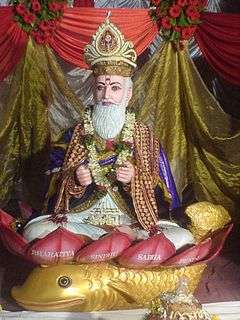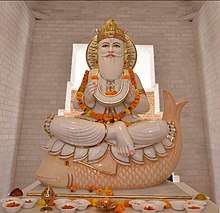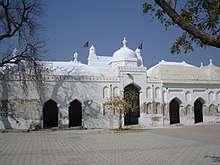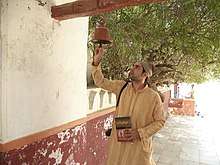Jhulelal (Hinduism)
Jhulelal is a name that refers to the Ishta Dev (most-revered deity) of Sindhi Hindus, who regard him to be an incarnation of the Hindu deity Varuna.[1][2] The chant Jhule Lal Jhule Lal is considered the "clarion call" of Sindhi Hindus.[3]His birth name was Uderolal (colloquially called Oderolal). It is said that the when Uderolal was a child, his cradle (swing) rocked itself to lull him to sleep, earning him the name Jhulelal - The Lord of the Swing[4]
| Jhulelal | |
|---|---|
 Jhulelal sitting on a lotus flower in the middle of a river and surrounded by a couple of silver fish (palla fish) | |
| Affiliation | Varuna Deva |
| Abode | Sea & River Indus |
| Weapon | Sword |
| Mount | Fish & Horse |
| Personal information | |
| Siblings | Arhastra |
Jhulelal is traditionally believed to have performed several miracles, typically centred around the Indus River, which Hindus consider to be his abode.[3] Sindhi Hindus worship Jhulelal at the Shrine at Odero Lal in Pakistan's Sindh province, which is jointly used by Hindus, and Sindhi Muslims who revere the shrine as the tomb of Sheikh Tahir. A second shrine named Jhulelal Tirthdham exists in India at Narayan Sarovar, Kutch, Gujarat.[5]
He is represented as a man with a flowing white beard, sitting on a lotus flower in the middle of a river and surrounded by a couple of silver fish (palla fish).[6] It is said that when the boy was born, he revealed his divine identity to his father Rattanchand and his mother Devaki. When he opened his mouth, his parents saw the mighty Sindhu river flowing and an old man seated on a palla fish (a large salmon indigenous to the Sindhu river).[7]
Legacy

Jhulelal is the Ishta Dev (preferred God) of Sindhi people.[1] Jhulelal continues to be the unifying force and the centre of all cultural activities of the Sindhi community. When Sindhi men venture out to sea, their women pray to Jhulelal for the men's safe return. They offer the Lord a prasad of akha, a sweet made from rice, ghee, sugar and flour. Sindhis all over the world greet one another with the words, "Jaiko chawando Jhulelal thenja thinde Beda-Paar".
Although the exact time and year of Jhulelal's incarnation is not known, his birth year is estimated sometime in the middle of the tenth century. It is widely believed among the Sindhis that the Water God incarnated as Jhulelal.
According to tradition, a tyrannical ruler named Mirkhshah from nearby Thatta ordered that local Sindhis to convert into Islam within twenty-four hours or sacrifice. Local Sindhis, fearful of this edict, prayed at the banks of the Indus River, where they then saw a vision of the deity Varuna, who informed the worshippers that he would reincarnate himself as an infant to be born in Nasirpur in order to deliver them from their hardships.[8]
Jhulelal was born on the first day of the Hindu month of Chaitra. This day is celebrated by Sindhi Hindus as Cheti Chand.[9][10][11] Upon hearing of the infant's birth, Mirkhshah commanded his minister Ahirio to kill the infant with a poisoned rose petal. When Ahirio saw the infant, Jhulelal smiled, and the poisoned rose petal blew out of Ahirio's possession. When Ahirio caught sight of Jhulelal for a second time, he was startled to see that the infant had grown into an elderly man. The elderly man was then said to have turned into a young man, and then a warrior on horseback before Ahirio's eyes.[12]
Ahirio returned to recount the story to Mirkhshah, who then lambasted Ahirio, and told him to leave and call out for Jhulelal by the banks of the Indus. Upon calling for Jhulelal, the warrior on horseback appeared out of the river to appear to Ahirio with an accompanying army. Terrified, Ahirio begged Jhulelal to restrain his army. Jhulelal's army then disappeared back into the River Indus, while Ahirio went back to the palace to recount the story to Mirkhshah. Mirkhshah remained skeptical, but invited Jhulelal to his court. Jhulelal is then said to have vanished, leaving Mirkhshah enraged. Jhulelal's followers then rushed to the house in Nasarpur where Jhulelal was born, and found Jhulelal there as an infant. The infant consoled the distraught Sindhis and commanded them to assemble at a temple near the Indus River. Upon assembling, a firestorm broke out and engulfed Mirkhshah's palaces. The king escaped to the banks of the river, where he found Jhulelal, now again a warrior, and his Sindhi followers protected from the firestorm. The kings fell at Jhulelal's feet, and Jhulelal dismissed the storm with the movement of his hand.[12]After saving the Sindhis, it is believed that he was swallowed up by the earth. A temple was built at this point, which is now called the Oderolal Shrine.[13]
Jhulelal is also believed by Sindhis to have performed miracles, such as entering the Indus river at Nasirpur and coming up at Bukkur, at the northernmost extent of Sindh.[3]
Festivals
Cheti Chand
The Cheti Chand festival in the Hindu month of Chaitra marks the arrival of spring and harvest, but in Sindhi Hindu community, it also marks the mythical birth of Uderolal in the year 1007.[10][11][9] Uderolal morphed into a warrior and old man who preached and reprimanded Mirkhshah that Muslims and Hindus deserve the same religious freedoms. He, as Jhulelal,[9] became the saviour of the Sindhi Hindus, who according to this legend, celebrate the new year as Uderolal's birthday.[9][10]
Chaliya saheb
Chalio or Chaliho, also called Chaliho Sahib, is a forty-day-long festival celebrated by Sindhi Hindus[14][15][16] to express their gratitude to Jhulelal for saving them from their impending conversion to Islam. The festival is observed every year in the months of July to August; dates vary according to Hindu calendar.[14][15] It is a thanksgiving celebration in honor of Varuna Deva for listening to their prayers.[14][15]
Odero Lal Shrine


The Jhulelal Shrine at Odero Lal is situated in Matiari District, almost 40 kilometers away from the Sanghar District of Sindh; The Hindus and the Muslims can pray here at the same place simultaneously.[17][18] Nawabshah, Hyderabad, Matiari, Sanghar and Mirpur Khas are the nearby major cities to reach at the Shrine near Tando Adam.[19]
It forms the seat of the Daryapanthis, originally a subsect of the followers of Gorakhnath, who belong to the Nath tradition.[1][20]
Jhulelal Tirthdham
Sindhi Hindus in India built a religious shrine and cultural complex in Kutch, near the border of Sindh Province.[21][5] The 100-acre complex includes a 100-foot statue of Lord Jhulelal, a museum, meditation centre, an auditorium, and a cultural and arts-and-crafts centre with 100 accommodations.[21][5] Aiming to be the "a centre for global Sindhi identity", [5] the project costs an estimated ₹100 crore and was built on the donations from wealthy Indian Sindhis.[21][5] Harish Fabiani, one of the key promoters of the project, stated regarding the cultural complex, "The younger generation is aware they are Sindhis, but they do not know their language. We must learn our language and culture. We should have a place we can call our own."[21]
Slogan of Jhulelal
Jeko chawundo Jhule Lal Tehnija Theenda Bera Paar (جيڪو چوندو جهولي لال ، تَنهن جا ٿيندا ٻيڙا پار)’ meaning- For whosoever says Jhulelal, will find all his desires fulfilled (By chanting Jhulelal's name -Your boat sailing through troubled waters will reach the shore safely).[22]
Iconography
- In the most common form, Jhulelal is represented as a bearded man sitting cross-legged on a lotus flower that rests on a palla fish.[23] The fish is seen floating on the Sindhu river. He holds a sacred text and sometimes even a rosary. He wears a golden crown with a peacock feather and wears regal clothes. Generally, temple idols represent him in this form.[24][25]
- In another form, he is shown standing on a palla fish or the lotus flower, holding a staff with both hands to indicate leadership.[26]
See also
References
- Story of Jhulelal Archived 2011-05-01 at WebCite
- http://www.sanskritimagazine.com/indian-religions/hinduism/supernatural-nature-sindhi-tradition/
- Lari, Suhail Zaheer (1994). A history of Sindh. Oxford. ISBN 0195775015. Retrieved 19 December 2017.
- https://www.livehistoryindia.com/snapshort-histories/2017/07/14/jhulelal-the-god-of-the-indus
- "Coming up in Gujarat, Sindhis' own sacred shrine - Times of India". Retrieved 12 May 2019.
- https://www.dawn.com/news/1227241
- https://www.livehistoryindia.com/snapshort-histories/2017/07/14/jhulelal-the-god-of-the-indus
- "The Supernatural in Nature of the Sindhi Tradition". Sanskriti Magazine. 7 April 2014. Retrieved 4 March 2017.
- S. Ramey (2008). Hindu, Sufi, or Sikh: Contested Practices and Identifications of Sindhi Hindus in India and Beyond. Palgrave Macmillan. pp. 8, 36. ISBN 978-0-230-61622-6.
- Mark-Anthony Falzon (2004). Cosmopolitan Connections: The Sindhi Diaspora, 1860–2000. BRILL. pp. 58–60. ISBN 90-04-14008-5.
- P. Pratap Kumar (2014). Contemporary Hinduism. Routledge. pp. 120–124. ISBN 978-1-317-54636-8.
- Bhavnani, Nandita (2014). The Making of Exile: Sindhi Sindhis and the Partition of India. Westland. ISBN 9789384030339.
- https://www.livehistoryindia.com/snapshort-histories/2017/07/14/jhulelal-the-god-of-the-indus
- Chaliho festival Archived September 16, 2011, at the Wayback Machine
- Sindhis celebrate Chalio festival
- Sindhi Festivals > Chaliho Archived April 25, 2012, at the Wayback Machine
- Zahida Rehman Jatt (June 3, 2015). "Jhulay Lal's cradle of tolerance". Dawn. Dawn. Retrieved 22 December 2015.
- Claude Markovits. The Global World of Indian Merchants, 1750–1947: Traders of Sind from Bukhara to Panama. Cambridge University Press, 2000. p. 48. ISBN 9781139431279. Retrieved 22 December 2015.
- "List of Cities near Udero Lāl in Sindh, Pakistan". GoMapper. Retrieved 22 December 2015.
- Jatt, Zahida Rehman (2017-03-07). "How this lesser known festival is celebrated annually by Hindus in Sindh". DAWN.COM. Retrieved 2018-09-16.
- Shradha Shahani. "Sindhis are building a Jhulelal Tirthdham—their own holy city". Retrieved 5 June 2019.
- Parveen Talpur. "Fish Symbol: Indus Civilization to Biblical References". parveentalpur.com. Retrieved 22 December 2015.
- Nadeem F. Paracha (December 20, 2015). "Jhulay Lal's full circle". Dawn. Dawn. Retrieved 22 December 2015.
- Mark-Anthony Falzon (2004). Cosmopolitan Connections: The Sindhi Diaspora, 1860–2000. 9. Brill Academic Publishers. p. 59. ISBN 90-04-14008-5. Retrieved 1 February 2014.
- Boivin, Michel (15 Oct 2008). Sindh through History and Representations: French Contributions to Sindhi Studies. Oxford University Press. p. 76. ISBN 9780195475036.
- Falzon, Mark-Anthony (2004). Cosmopolitan Connections:The Sindhi Diaspora, 1860–2000 (International Comparative Social Studies, Vol. 9). Brill Academic Publishers. p. 59. 9789004140080.

